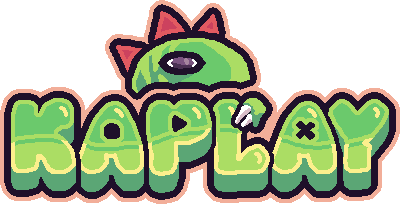Optimization Tips
Here’s some tips on optimizing performance / maintainability for KAPLAY games
Game Object is not always the answer
Game objects are great for managing game entities, but they have a cost. If you
are only rendering a static image, or a simple shape, you can use onDraw with
drawSprite or drawRect instead of creating a game object.
// create a game object
const player = k.add([
k.sprite("bean"),
k.pos(100, 200),
k.scale(4),
k.opacity(0.5),
]);
// draw a sprite directly
k.onDraw(() => {
k.drawSprite({
sprite: "bean",
pos: k.vec2(100, 200),
});
});If you’re creating and destroying objects in an absurd rate, you should find another solution.
- Particles:
particles()component instead of creating and destroying objects for each particle. - Rendering:
onDrawfor rendering static images or shapes. - Text:
text()ordrawText()transform instead of creating a game object for each letter/word. - Data:
const gameData = {}for storing game state instead of creating a game object the state.
Cleanup One-off Objects
Sometimes there are some objects that gets created, leaves screen, and never seen again, like a bullet. These objects will keep being rendered / updated and be detrimental to performance if they get created a lot, it’s better to remove them when they leave screen.
offscreen() is a component that helps you define behavior when objects go
off-screen.
k.add([
k.sprite("bullet"),
k.pos(player.pos),
// the bullet move left forever
k.move(LEFT, 600),
// destroy the bullet when it's far out of view
k.offscreen({ destroy: true }),
]);Hide Off-Screen Objects
Sometimes you might be drawing a lot of objects that’s not on screen (e.g. if
you have a big map and your camera only sees a small area), this is very
unnecessary, use offscreen() component to define object’s behavior when
they’re not on screen.
// planting flowers all over the map
for (let i = 0; i < 1000; i++) {
k.add([
k.sprite("flower"),
k.pos(k.rand(-5000, 5000), k.rand(-5000, 5000)),
// don't draw or update the flower when they're out of view
k.offscreen({ hide: true, pause: true }),
]);
}Avoid Global Namespace
By default KAPLAY uses a lot of common names like pos, sprite that occupies
global namespace, it’s often better to use KAPLAYOpt.global in false to not export KAPLAY
functions to window
const k = kaplay({
global: false,
});
const pos = k.vec2(120, 200);Compress Assets
Loading assets takes time, compress them when you can.
- Compress
.ttfor.otfto.woff2(with google/woff2) - Compress
.wavfiles to.oggor.mp3
Use Game Object local timers
When programming timer / tween behavior for a specific game object, it’s better
to attach timer() component to the game object and use that instead of global
timer functions. This way the timer is tied to the life cycle of the game
object, when the game object pauses or gets destroyed, the timer will not run.
// prefer
const player = k.add([
k.sprite("bean"),
k.pos(100, 200),
k.timer(),
k.state("idle"),
]);
// these timers will only run when player game object is not paused / destroyed
player.wait(2, () => {
// ...
});
await player.tween(
player.pos,
k.mousePos(),
0.5,
(p) => (player.pos = p),
k.easings.easeOutQuad,
);
// this will pause all the timer events
player.paused = true;
// this will stop all the timer events
player.destroy();
player.onStateEnter("attack", async () => {
// ... state code
// if we use global k.wait() here it'll create infinitely running state transitions even when player game object doesn't exist anymore
await player.wait(2);
player.enterState("idle");
});
player.onStateEnter("idle", async () => {
// ... state code
// if we use global k.wait() here it'll create infinitely running state transitions even when player game object doesn't exist anymore
await player.wait(1);
player.enterState("attack");
});Use Game Object local input handlers
Similar to above, it’s often better to use local input handlers as opposed to global ones.
const gameScene = k.add([]);
const player = gameScene.add([
k.sprite("bean"),
k.pos(100, 200),
k.area(),
k.body(),
]);
// these
gameScene.onKeyPress("space", () => {
player.jump();
});
// this will pause all the input events
gameScene.paused = true;
// this will stop all the input events
gameScene.destroy();
